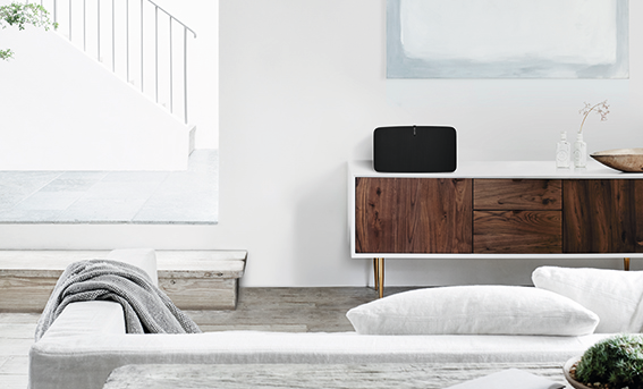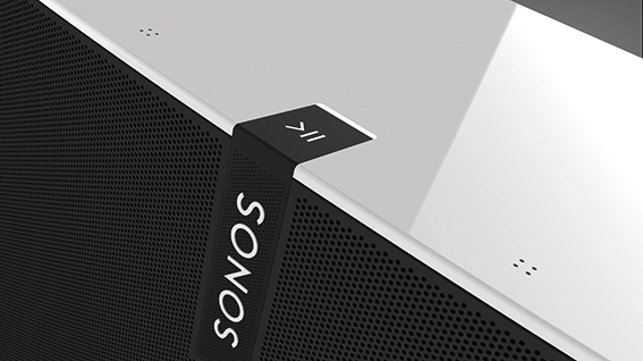
The simple form of the Sonos Play:5 speaker has been purposefully designed to fit into any home interior
The creative director of Sonos Dana Krieger takes it as a compliment when I refer to the company’s latest flagship speaker the Play:5 as simple.
“We are totally happy with you using the word simple. That is what we are trying to do,” he smiles.
“We believe in simple forms because music is the hero of the Sonos experience and we never want our hardware to compete with that. Where we communicate our value and unique point of view is in the small details.”
Small details like the pattern of holes in the Play:5’s grill. “Due to the nature of our products we spend a lot of time thinking about holes. With the Play:5 it was 60,000 holes and each one is specifically placed so that we control the way the pattern meets the edge profile of the product,” explains Krieger.
Every small detail of Sonos’ home audio products is scrutinised in development to set them apart from competitors both in how they look in the home and in how they operate. For instance, all its products feature a wireless connection and stream music from devices around the home because Sonos’ founders took a bet in the early days when setting up the company in 2002 that streaming would fundamentally change the way we listen to music. How right they were.
From the ground up
The biggest of Sonos’ three speakers, the first generation Play:5 was launched six years ago.
With the growth of its design and engineering teams together with new capabilities and resources in-house, the company’s goal with the new Play:5 was to leapfrog this original and design something completely new from the ground up.
“When we started to design the new Play:5 we were initially planning to reuse components but we soon realised that to build a flagship speaker product we needed to have a massively better audio and wanted to improve on our rock solid wireless performance.
“In addition to that we had a lot more experts and knowledge in-house and were able to create everything custom — mid-woofers, tweeters as well as electronics, boards and internal parts,” explains Stefan Reichert, industrial designer.
The design process at Sonos is very collaborative with designers working alongside multidisciplinary colleagues in the design and engineering departments. And, of course, due to the nature of what they are designing, initial concept work involves a close relationship with the acoustic engineers to ensure the right trade off is found between acoustic performance and usability.
With the Play:5 the designers were set on a certain form as they felt it would fit well in the user’s home and so challenged the acoustic engineers to help them achieve this.
“The real magic is when the design and acoustics enhance each other and our sub woofer is a wonderful example of this alignment,” comments Krieger. “The sub woofer delivers profound bass through its opposing drivers and the symmetrical layout of these components around the central void enhances functionality by eliminating any vibration and gives the product its powerful monolithic presence.”

The controls of the Play:5 include a touch interface with volume up/down, previous/next track and play/pause
Raising the bar
However, this simplicity the designers were after proved to be the biggest challenge from a mechanical engineering perspective.
It’s essentially just two pieces — a seamless enclosure with a grill at the front. “The design team really wanted to raise the bar in terms of the build quality and finish of the parts.
The gaps had to be as tight as we could get them. It’s a level of refinement and fit that we have never achieved at Sonos before,” says Ron Roberts, mechanical engineering lead on the Play:5.
For this project, the design team used a mix of tools including Rhino, Adobe Illustrator and Autodesk Alias to design their parts. The file, often in .IGES format, would then be brought into the mechanical design team’s CAD tool Creo.
“Often a part would be rebuilt completely in Creo but the risk is always that there would be small mistakes or differences in the way that a mechanical engineer modelled a part relative to how an industrial designer may have built that part in their CAD tool,” explains Roberts.
However, following a recent transition to Siemens NX for product development and with a member of the industrial design team now also using NX, the workflow according to Roberts is a lot cleaner and supports better collaboration.
“As we go forward the designers may even use NX to do their concept development as well. This will mean it’ll be much easier to iterate on the designs and we will have a higher level of confidence in the fact that there is a greater alignment between design intent and mechanical parts.”

A Keyshot rendering of the inside of the grill
The heat is on
Another challenge during product development was heat.
The Play:5 is full of electronics (similar components to that of a PC) and with a sealed acoustical architecture no air can get in or out.
“It’s a very powerful player. There are three large woofers that are heating the air inside the enclosure as well as electronics components, amplifiers, CPUs, wi-fi and the radio section which are all generating heat,” says Roberts.
The engineers could not devise a thermal solution to decrease the heat so the only option was to develop a design that was tolerant of running at very high temperatures. “Everything from the plastics we mould the parts from to the foam we use to control buzz and the adhesives was selected against a spec of higher operating temperatures.
“There were then a couple of components that did need some direct thermal management — particularly the CPU used for some of the wi-fi parts that just couldn’t tolerate running at the higher temperature,” adds Roberts.
Very early on in the product development phase thermal models were being built and tested digitally in CAD. Later on prototypes were built and physically tested in hightemperature ovens that simulate extreme conditions to ensure the speaker would not overheat under heavy usage.

Built-in rubber feet, which have been very subtly designed, mean that the Play:5 can be placed either horizontally or vertically
It’s in the details
With the engineers agonising over the fit of the enclosure and heat generation, the industrial designers were agonising over the 60,000 holes and their careful placement on the speaker’s grill.
“As designers these are the tiny details that we geek out at a lot,” laughs Krieger. “The centres of each hole are custom positioned so that the way the grill pattern subtly terminates at the edge of the grill is consistent all the way round.”
However, although such a clean border that featured no jagged edges or half holes was great in principle, was it in fact achievable?
“The design team are really looking to differentiate Sonos products from other products in the market place in large part by pushing us to learn more about how things are made,” admits Roberts.
“We really don’t use the question ‘how will it be made’ to sort through design concepts because if we do we’ll end up down the road of using commercially available commodity technologies and it then gets harder to differentiate our products,” he adds.
Carrying out research with its manufacturing team based in Shanghai, China, the team soon realised that, although there are techniques to punch hole patterns, it’s really difficult to punch up to an edge and not continue past it.
They also looked at ways of drilling the hole pattern but soon realised that it could become very expensive very quickly. However, they came across some manufacturing equipment that uses a technique of CNC drilling lots of small precise holes into printed circuit boards.
So, they adapted it and essentially invented their own manufacturing process. The industrial design team was onboard with this technique because it met with their goal of creating a product of the highest quality with utmost attention to the small details as the definition that can be achieved with CNC drilling is so much sharper than that of an injection moulded drill.
“It wasn’t that expensive either once you really try and find all the opportunities there are to maximise its efficiency and its yield and you understand all the things that contribute to cycle time. We had to do a real deep dive on that so that we could get the design really optimised,” explains Roberts.
Another advantage and cost saving element of this process is there is almost no investment in tooling. “Tooling can become very expensive and once you make a commitment to tooling you start locking the design in. But with the grill we were still tweaking the hole pattern and the perimeter shape until quite far along.
“So we got the custom made look and custom hole pattern and we had the flexibility to tune it as we went through our process,” comments Roberts.

To create its desired sound, the speaker features six digital amplifiers, three tweeters and three mid-woofers
Level of refinement
Another small detail that the design team agonised over was the design of the product’s feet.
An important aspect of the Play:5 is that it can be placed in three orientations — on its long side or two ends — and the sound adjusts accordingly.
So, in a product where the bottom can be the top and vice versa these feet had to be unobtrusive and also prevent the speaker ‘walking’ off the surface.
“The feet are critical so that the speaker stays stable but we really consider these details so if you happen to put the product on one of its faces you don’t feel like you are seeing an upside down product,” describes Krieger.
The foot design started relatively early in the design process and the design team were still refining it until the very end.
“Initially we had a magnetic solution that would attach to the bottom but after user testing and discovering that if the user forgot to put the feet on and with the risk of it falling and hurting someone, we decided to switch to a permanently attached solution,” says Reichert.
“Prototyping each iteration of feet with our 3D printer in a rubber material and applying them to our actual speakers helped us a lot to minimise the size to the smallest we could achieve while still keeping all its needed features,” adds Reichert.
The Play:5 was launched towards the end of 2015 in both matt black or white versions. It is indeed a simple speaker to look at but it’s those small details that Krieger hopes will make the user’s relationship with the product stronger the longer they own it.
“A customer may not be able to specifically say why our products feel different but the sum total of all the details we scrutinise in product development is a unique point of view that we are proud of,” he says.
“Customers live with our products for ten years or more and maybe in year six or seven they notice how the hole pattern subtly terminates at the edge of the grill.
We want all of those moments and small scale interactions with our product to increase how much people love Sonos.”

We talk to the team behind the creation of the Sonos Play:5 speaker
Default






